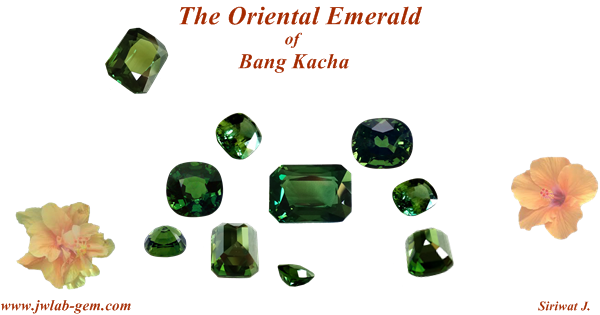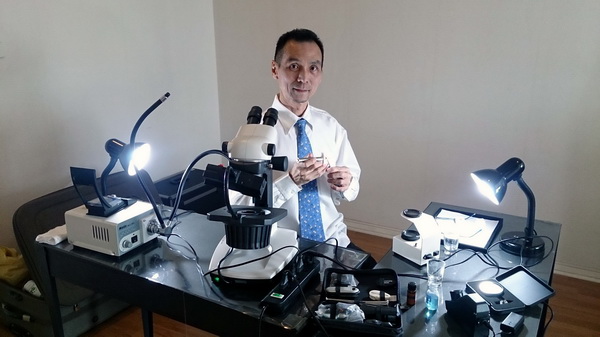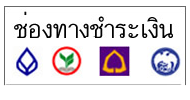The Oriental Emerald of Bang Kacha

The Oriental Emerald of Bang Kacha
The twists and turns of high way 3147 through the jungle and valley of Bang Kacha (a district of Chantaburi province) which is covered with the greenery of tropical vegetation and some village fruit orchards seems to be major attraction that cast a spell to all visitors. Besides the scenic mountain, who know what the verdurous scenery has concealed if there is another dimension of aesthetics to be unrevealed? It is the beauty that waits to be explored, unearthed, cleaned and polished so that its brilliance and its verdant color will display: it is the compelling green radiance that shines as though it competed with its surrounding greenery. Certainly, this glittering green gems is the famous “Green Sapphire of Bang Kacha”. People of the eastern province in Thailand call it as “the Emerald of Chantaburi”. This name coincides with the westerner term “the Oriental Emerald”. (Do not confuse with beryl emerald which is a softer gem.) I prefer use the term “green sapphire” that is the standard scientific name. The green sapphire is a variety in corundum species which is rated the second hardest mineral next to diamond (9 on the hardness scale). The corundum family comprises ruby, blue sapphire, yellow sapphire, green sapphire and various star sapphires that will be discussed later on.
The green sapphire had been discovered since centuries ago in area of Bang Kacha, Chantaburi province. It is found underground with other corundum varieties in the basalt layers or in the alluvial deposits. In the mine of Bang Kacha, the proportion of green sapphire seems to be greater than other colored sapphires. My admiration for this green gem in particular has been because it always reminds me of the greenery of the tropical forests, mountains, grasslands and country paddy fields. The green of sapphire is certainly not comparable to the hot red of ruby which is dominant and reflects the intense emotions. The green sapphire, on the contrary, may represent discretion, serenity, nature and simplicity. The color of green sapphire comes from iron (Fe) as a trace element in corundum. Iron element provides a sober, modest and classical green shade in sapphire that is compatible for both male and female jewellery. Its characteristic cool green ranges from the tender pastel green, lively yellowish green, bluish green, mid green to the solemn dark green. The most sought after is the yellowish mid green shade called “jasmine leave color”. We can easily select the shade that matches our personal taste and style, particularly in male jewellery. Green sapphire is quite distinct from emerald. Emerald (beryl) has the green hue that derives from chromium (Cr) as a trace element in beryl. The vibrant green of emerald may be too prominent and bold for the taste of certain persons, as it seems to match the female style (particularly in dress jewellery) rather than male items. In such aspect, green sapphire may serve as a subdued alternate for emerald.
The quantity has inclined considerably in recent years, as large number of rough green sapphires are supplied to the process of color alteration: heating to bring out yellow from the green that results in yellow sapphire (read “Gem alteration” and “Miracle of fire & gemstones”. ) Green sapphires have now become more scarce. Anyhow, hunting for green sapphire of good quality is still feasible. Do not hesitate to keep some attractive stone in your collection before the famous “Green Sapphire of Bang Kacha” will become a legend like the “Siamese Ruby”.
Definition : ”Hard Gem” : Previously, Europeans) knew only the familiar local gemstones. For example red spinel was called “balas ruby”, any yellow gem was called “topaz”, green beryl was called “emerald” etc. Later, when Europeans had more commercial contact and relationship with the east, the corundum gemstones were then introduced to westerners and became widespread in Europe. Eventually the Europeans created new term to label these corundum gems (which is known to be relatively harder than their local gem variety) and differentiate them from their local ones. They adopted the word “oriental” in front of the name of a particular gemstone( of the same color) thus the ‘prefix’ indicates the origin of the gems and, at the same time, prevents people form confusion. For example, a ruby from Myanmar is called”an oriental ruby”, a yellow sapphire from Sri Lanka is called “an oriental topaz” and green sapphire is called “an oriental emerald”. They maintained the root description of their local gemstones. So when we see the word “oriental” in front of the name of any gemstone, it belongs to the corundum gems – the hard gemstones from Asia.
Mr. Siriwat Jimanusorn
คลีนิกอัญมณี
"คลีนิกอัญมณี" เป็นคอลั่มน์รวมบทความต่างๆทางอัญมณีศาตร์ ทั้งที่เกี่ยวกับแวดวงการค้าอัญมณี และในเชิงวิชาการของการตรวจวิเคราะห์พลอยประเภทต่างๆในห้องแลบ ยังรวมไปถึงเรื่องราวอัญมณีที่อยู่ในกระแสความสนใจซึ่งอาจมาจากคำถามที่พบบ่อยเป็นต้น บทความที่ผมเขียนขึ้นจะถูกรวบรวมไว้ในที่นี้ ท่านสามารถติดตามบทความใหม่ของเราที่จะนำเสนอเป็นระยะๆ รวมถึ่งการอ่านเรื่องย้อนหลังได่อีกด้วย
วัฒน์
(หมอพลอย)


SEARCH
Categories
MEMBER
- ระดับ{{userdata.dropship_level_name}}
- ไปหน้าหลักตัวแทน
- ทั้งหมด {{(order_nums && order_nums.all)?'('+order_nums.all+')':''}}
- รอการชำระเงิน {{(order_nums && order_nums.wait_payment)?'('+order_nums.wait_payment+')':''}}
- รอตรวจสอบยอดเงิน {{(order_nums && order_nums.wait_payment_verify)?'('+order_nums.wait_payment_verify+')':''}}
- รอจัดส่งสินค้า {{(order_nums && order_nums.wait_send)?'('+order_nums.wait_send+')':''}}
- รอยืนยันได้รับสินค้า {{(order_nums && (order_nums.wait_receive || order_nums.wait_confirm))?'('+(order_nums.wait_receive+order_nums.wait_confirm)+')':''}}
- รอตรวจสอบข้อร้องเรียน {{(order_nums && order_nums.dispute)?'('+order_nums.dispute+')':''}}
- เรียบร้อยแล้ว {{(order_nums && order_nums.completed)?'('+order_nums.completed+')':''}}
- ทั้งหมด {{(order_nums && order_nums.all)?'('+order_nums.all+')':''}}
- รอการชำระเงิน {{(order_nums && order_nums.wait_payment)?'('+order_nums.wait_payment+')':''}}
- รอตรวจสอบยอดเงิน{{(order_nums && order_nums.wait_payment_verify)?'('+order_nums.wait_payment_verify+')':''}}
- รอจัดส่งสินค้า {{(order_nums && order_nums.wait_send)?'('+order_nums.wait_send+')':''}}
- ส่งสินค้าเรียบร้อยแล้ว {{(order_nums && order_nums.sent)?'('+order_nums.sent+')':''}}
STATISTICS
| หน้าที่เข้าชม | 370,545 ครั้ง |
| ผู้ชมทั้งหมด | 273,296 ครั้ง |
| เปิดร้าน | 17 ก.พ. 2559 |
| ร้านค้าอัพเดท | 20 ส.ค. 2568 |
CONTACT US
LINK
ติดต่อสอบถาม
 โทรศัพท์: 081-8102763
โทรศัพท์: 081-8102763
![]() LINE ID: siriwat28
LINE ID: siriwat28
 siriwat.jiamanusorn@gmail
siriwat.jiamanusorn@gmail
 Fanpage: @jwlab.gem
Fanpage: @jwlab.gem

TRACK&TRACE

TOP เลื่อนขึ้นบนสุด





